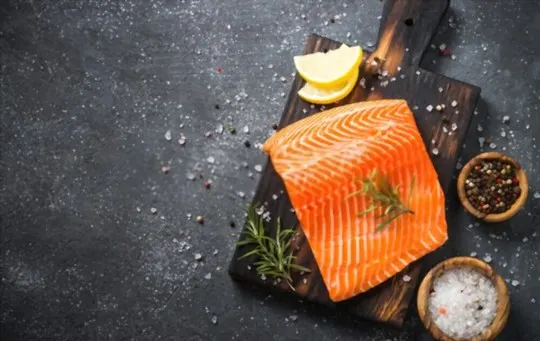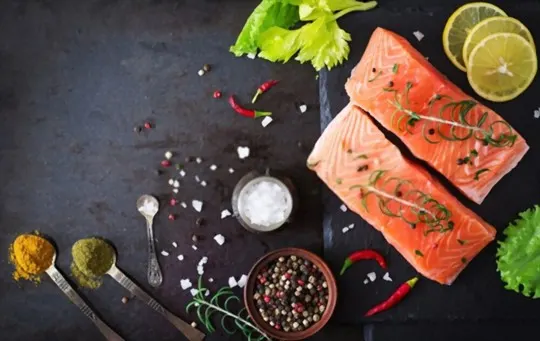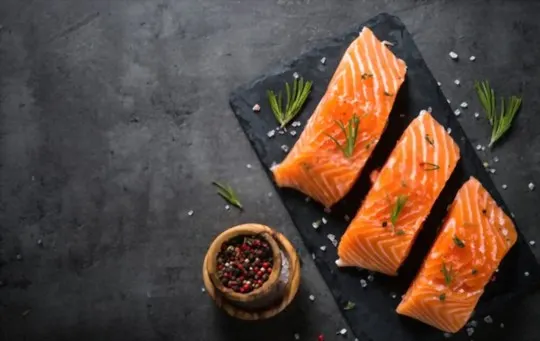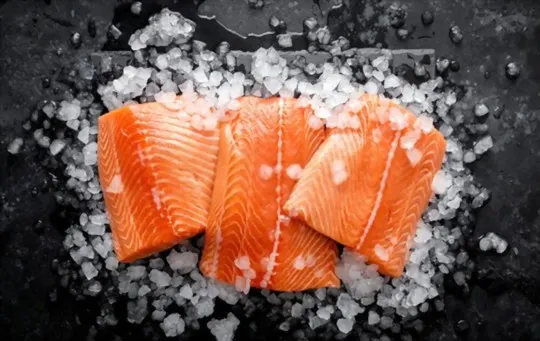Do you love seafood but can’t quite put your finger on what salmon tastes like? No problem!
We understand that it’s hard to describe the flavor of this good-for-you fish, which is why we created this comprehensive guide breaking down everything you need to know about its flavor.
In this post, we’ll explore the different types of salmon, their unique flavors and textures using real life examples, and even tips for cooking up some perfectly flavored dishes at home.
Our aim is to help you get an understanding of how delicious yet simple preparing salmon can be.
So let’s dig in – buckle up and let’s try to make sense of what does a Salmon Really Taste Like?
What is Salmon?

Salmon is one of the most amazing fish species that can be found in aquatic habitats all over the world.
It’s a prized seafood option due to its mild, yet flavorful taste and its incredibly healthy omega 3 fatty acid content.
In addition to being an excellent source of protein, it offers essential nutrients like magnesium, selenium, and vitamin B12 – which provide a wide array of health benefits.
Salmon also has an interesting life cycle; they begin their life in freshwater, travel to the sea as adults, then return to the same stream where they were born in order to spawn.
This cycle helps ensure that local populations have a steady food source and can help nourish the ecosystem for years to come.
All in all, salmon is not only delicious but also has many helpful properties for both people and nature.
What Does Salmon Taste Like?

Salmon has a distinct flavor that can be described as rich, buttery, and slightly sweet.
Its taste can vary depending on the type of salmon, its diet, and how it’s prepared.
Here’s a breakdown of the different types of salmon and the flavors they offer:
- Chinook: Also known as king salmon, this variety has high-fat content, giving it a buttery and rich taste.
- Sockeye: Sockeye salmon has a bold and full flavor, with a deep red flesh color that is visually appealing.
- Coho: Coho salmon has a medium fat content, making it a mild and delicate flavor that is great for grilling.
- Atlantic: Atlantic salmon has a mild, smooth, and light flavor that makes it versatile and easy to add to any dish.
In terms of preparation, salmon can have different tastes depending on whether it’s grilled, baked, smoked, or raw.
Grilling and smoking can give salmon a smoky flavor, while baking allows it to retain its natural flavor.
Raw salmon, often served in sushi dishes, can have a delicate, buttery taste.
Overall, salmon is a healthy and delicious option for seafood lovers, and its unique and versatile taste makes it a popular choice for many dishes.
Factors that Affect the Taste of Salmon

Salmon is a versatile fish that can be prepared in many ways, but the taste can differ greatly depending on various factors.
Here are the key factors that affect the taste of salmon:
- Species: Different species of salmon have varying taste profiles. For example, sockeye salmon has a rich, bold flavor, while pink salmon is milder and more delicate.
- Diet: The diet of the salmon affects its taste. Wild salmon feed on small fish and plankton, resulting in a more complex and flavorful taste. Farmed salmon, on the other hand, may be fed a pellet-based diet, resulting in a milder taste.
- Environment: The environment in which the salmon lives affects the taste. Wild salmon that swim upstream and spawn in colder waters have firmer flesh and a more assertive flavor. Farmed salmon may be raised in densely populated pens, resulting in softer flesh and a less robust flavor.
- Preparation method: The way you cook your salmon also affects its taste. Grilling, broiling, and pan-frying can add smokiness and a crispy texture, while poaching and baking can be gentler and more delicate.
Knowing these factors can help you choose the right type of salmon for your recipe and prepare it in a way that brings out the best flavor.
Pro tip – Opt for wild-caught salmon whenever possible for the best taste and nutritional value.
1 – Species
Species is a significant factor in determining the flavor profile of salmon, and it can vary widely depending on the species.
- Atlantic Salmon: This species is mild and slightly sweet with a delicate texture.
- Chinook Salmon: Also known as King Salmon, it has a rich, buttery flavor and a high oil content.
- Coho Salmon: This species is milder than Chinook with a delicate, flaky texture and a subtle flavor.
- Sockeye Salmon: Sockeye has a rich, distinct flavor with a firm texture and a vibrant red color.
- Pink Salmon: Pink salmon is the most affordable option and has a milder taste than other species.
In general, salmon has a sweet and buttery taste, a tender and flaky texture, and a slightly fishy flavor.
The flavor can also vary depending on the salmon’s diet, fat content, and method of preparation.
Raw salmon has a richer taste and firmer texture than cooked salmon.
2 – Diet
Salmon is a flavorful and versatile fish with a distinctive taste that varies depending on the species, preparation method, and cooking technique.
Here are some general characteristics of the taste of salmon:
- Mild: Salmon has a mild and delicate flavor that is often described as slightly sweet.
- Buttery: Some species of salmon, such as King (Chinook) salmon, have a buttery flavor profile that pairs well with rich sauces and seasonings.
- Earthy: Other species, such as Coho (Silver) salmon, have a more earthy taste with a firmer texture that holds up well to grilling and smoking.
- Rich: Wild salmon has a richer and more robust flavor than farm-raised salmon due to its natural diet and active lifestyle.
- Fishy: Raw or undercooked salmon can have a slightly fishy taste that some people find unappealing. However, this can be easily avoided by cooking salmon thoroughly.
In summary, salmon has a mild, buttery, earthy, rich or fishy taste depending on the species, preparation, and cooking method.
Ultimately, the taste of salmon is subjective and can vary from person to person.
3 – Preparation Method
Salmon is a popular seafood that is known for its distinct flavor and versatility.
Its taste can vary depending on various factors such as the type of salmon, its diet, and the method of preparation.
Here’s how different types of salmon taste like:
- Atlantic Salmon: This variety is known for its mild, delicate, and tender flavor. It has a subtle sweetness and a buttery texture.
- Sockeye Salmon: Sockeye salmon is rich and full-flavored, with a deep red color and a firm texture. This variety has a distinct “salmon-y” taste and is perfect for grilling or smoking.
- Coho Salmon: Coho salmon has a milder flavor than sockeye salmon, with a delicate and tender texture. It has a delicate flavor that is best highlighted with simple preparations like poaching or steaming.
- King Salmon: King Salmon, also known as Chinook Salmon, is the largest and fattiest variety of salmon. It has a buttery texture, a rich savory flavor, and intense marbling.
- Chum Salmon: Chum salmon has a mild and delicate flavor, with a firm texture and medium flakes. It has a low oil content and is best suited for grilling or smoking.
In conclusion, the taste of salmon can vary based on the type you select and the preparation method you use.
Experiment with different types of salmon and preparation techniques to find your ideal flavor profile.
Health Benefits of Eating Salmon

Salmon has a unique, rich flavor and a distinct texture that makes it a favorite among fish lovers.
But beyond its taste, salmon is packed with essential nutrients that offer numerous health benefits.
Here are some of the most significant health benefits of eating salmon:
- Rich in Omega-3 Fatty Acids: Salmon is a great source of omega-3 fatty acids, which are essential for maintaining heart health, improving brain function, and reducing inflammation in the body.
- High in Protein: This fish is also an excellent source of protein, which is essential for building and repairing tissues in the body.
- Rich in Vitamins and Minerals: Salmon contains a variety of vitamins and minerals, including vitamin B12, vitamin D, and selenium, which can help support immune function, boost energy levels, and promote healthy skin and hair.
- May Help Reduce the Risk of Chronic Diseases: Eating salmon regularly has been linked to a reduced risk of several chronic diseases, including heart disease, diabetes, and some types of cancer.
With its delicious taste and numerous health benefits, salmon is an excellent addition to any diet.
The next time you’re at the grocery store or a seafood market, be sure to pick up some fresh salmon and enjoy all that this flavorful fish has to offer.
How to Cook Salmon to Enhance its Flavor?
Salmon is a versatile and flavorful fish that is widely consumed across the world.
It has a rich and buttery taste, with a hint of sweetness and a tender, flaky texture.
To enhance the natural taste of salmon, follow these cooking tips:
- Choose fresh, high-quality salmon to get the best flavor.
- Season your salmon with salt, pepper, and other spices to add depth and complexity to the taste.
- Cook your salmon on a medium heat to prevent overcooking and drying out the fish.
- Make sure the internal temperature of the salmon reaches 145°F (63°C) to ensure it is cooked thoroughly.
- Serve your salmon with a squeeze of fresh lemon juice or a drizzle of olive oil to add acidity and freshness to the flavor.
By following these tips, you can cook salmon to mouth-watering perfection and bring out its delicious flavor.
Popular Dishes Made with Salmon

Salmon is a popular and versatile fish that can be cooked in many different ways and used in a variety of dishes.
Here are some of the most popular dishes made with salmon and their unique flavor profiles:
- Grilled Salmon: Grilled salmon has a smoky and slightly charred flavor along with the trademark tender texture of salmon.
- Salmon Sushi: Raw salmon used in sushi offers a buttery and melt-in-the-mouth texture with a subtle sweetness.
- Smoked Salmon: Smoked salmon has a distinct smoky flavor, making it perfect for bagels, sandwiches or appetizers.
- Baked Salmon: Baking salmon in the oven locks in its natural flavors, resulting in a tender and moist fish with a rich taste.
- Salmon Chowder: A stew made with salmon is packed with the salmon’s umami flavor, combined with cream or coconut milk to give it a rich consistency.
The taste of salmon can vary depending on the type, cooking method and seasoning used.
Typically, salmon has a rich, buttery flavor with a somewhat sweet undertone, and a tender yet firm texture.
It can range from mild to full-flavored, making it a versatile fish to work with in cooking.
Where to Buy Salmon and How to Store It?

Salmon is a versatile and flavorful fish that can be purchased from a variety of sources including grocery stores, seafood markets, and online retailers.
When buying salmon, it’s important to keep in mind the quality and freshness of the fish, as well as how it will be prepared and stored at home.
Here are some tips for buying and storing salmon:
- Look for salmon with firm and bright flesh and a mild scent. Avoid fish that appears dull or has a strong “fishy” odor.
- Buy salmon from a reputable supplier of fresh seafood or from a sustainable farm.
- Store fresh salmon in the refrigerator at a temperature below 40°F and use it within 1-2 days of purchase.
- If you bought frozen salmon, thaw it in the refrigerator overnight or under cold running water before cooking.
Salmon has a rich, buttery flavor with a mild, earthy taste that pairs well with a variety of seasonings and spices.
Additionally, wild salmon will have deeper red flesh with a more robust flavor than farmed salmon.
Overall, salmon is considered a healthy and delicious source of protein, omega-3 fatty acids, and other essential nutrients, which makes it a popular choice for a wide range of recipes, from grilled and baked to smoked and poached.
Conclusion
In conclusion, salmon can have a range of flavors depending on its species, diet, and cooking method.
Here are some key takeaways:
- Atlantic salmon is mild and buttery, while Pacific salmon has a stronger flavor and meatier texture.
- Wild-caught salmon has a more complex flavor than farm-raised salmon.
- The way salmon is cooked can also impact its taste; grilling and smoking can bring out the fish’s natural flavor, while more flavorful ingredients like teriyaki or soy sauce can overpower it.
To fully appreciate the flavor of salmon, it’s essential to try different types and cooking techniques until you find your preferred flavor profile.

What Does Salmon Taste Like? A Comprehensive Guide
Ingredients
- Salmon
- Ingredients from your selected recipes
Instructions
- Select your favorite ingredient from the range available in this article.
- Collect all the necessary items to make the recipe.
- Use the instructions provided to prepare a delicious dish in 30 minutes or less.

Carrie is a food writer and editor with more than 15 years of experience. She has worked for some of the biggest names in the food industry, including Bon Appétit, Food & Wine, and Martha Stewart Living.
As the Editor in Chief of IntroChicago.com, Carrie oversees all of the content on the site. She also manages the team of contributing writers and editors, who help to create delicious recipes, helpful tips, and informative articles that you’ll find on the site.
A native of the Chicago area, Carrie is passionate about all things food. She loves trying new restaurants and experimenting with new recipes in her kitchen. She’s also a graduate of the Culinary Institute of America, so she knows a thing or two about food!
